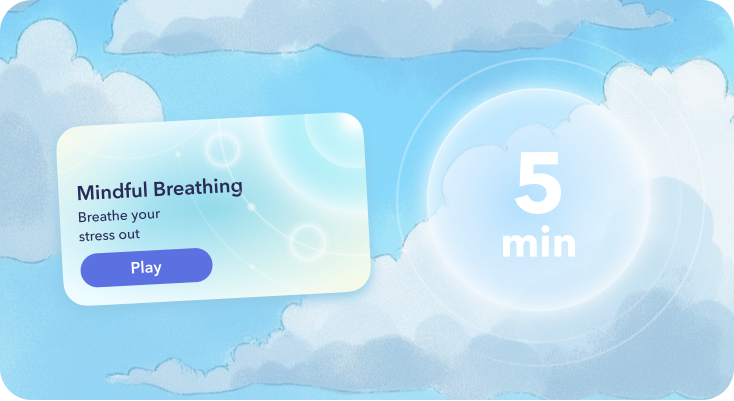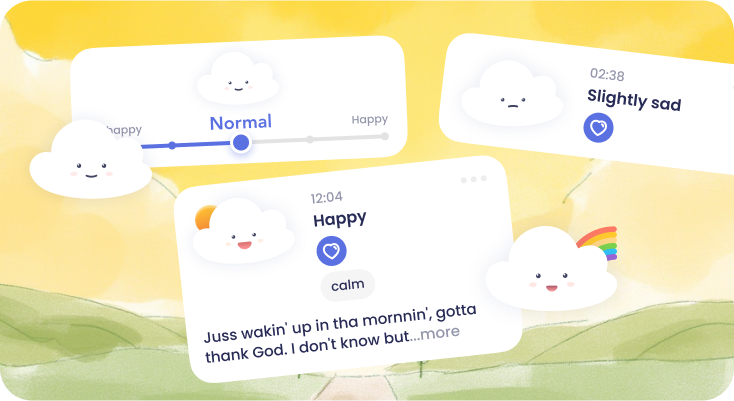You’ve been working on the challenging project for long hours and now simply can’t shift the focus. Or, maybe you started dwelling on a particular thought and now can’t get rid of negative feelings. Stressful thoughts run through your mind repeatedly while nothing seems to help.
In this article, we’ve collected ideas on how to clear your mind much faster and more easily. Get out of the endless loop and create space for focus, calm, and clarity. Whether it’s mental fog, overthinking, or emotional clutter, these techniques can help you feel back in control.
Effective ways to ground yourself and get rid of distracting thoughts
Repetitive or intrusive thoughts can be a natural response to chronic stress or past overwhelm. While these patterns can feel distressing, they often reflect your brain’s attempt to stay safe or in control. Mental fog or disconnection can also result from long-term stress or unresolved trauma, not just from doing too much, but from the body trying to protect itself.
1. Write down a to-do list
You need to finish this report, write a few SMM posts, prepare a presentation, pick up the kids from school, and get your nails done. This number of tasks may seem overwhelming, especially if you keep it in your head. No wonder you may forget something.
In this case, creating a to-do list and following it can help you reduce stress and let your brain focus on how to do things instead of what you need to do. Save these strategies for planning effectively.
Start with a “brain dump”
Note everything that you need to do: today, in a week, regularly, or even someday soon. Keeping these things in mind can cause chronic stress and lead to anxiety.
Group similar tasks
For instance, if you need to pay for your apartment every month, you might set up a reminder in your calendar and forget about it until the date. The same might work with a lot of regular tasks. Even more, you can group all small tasks and spend time doing them one by one. This will give your brain a sense of control.
Prioritize your tasks and add time estimates
Solving problems step-by-step, depending on their urgency, helps you clear your mind and avoid decision fatigue. Adding rough time estimates next to each task also helps you plan your day more realistically and keeps you from trying to do too much at once.
Keep it visible
You can use a planner, app, or sticky note — whatever works. Also, you can try routines in the Breeze app to track your consistency in regular tasks. Seeing your progress every day will help you stay highly effective.
2. Take a break and do breathing exercises
Studies prove that breathing is an effective way to manage stress and reduce cortisol levels. [1] Everything you need to do is find a quiet place and try some practices.
4-7-8 breathing
- Breath in through your nose for 4 seconds
- Hold your breath for 7 seconds
- Breath out through your mouth for 8 seconds
Counting breaths
Focus on your breath, count each inhale and exhale up to 10, and then start over. This exercise will help you get back to the present moment and concentrate on your body and feelings instead of ruminating on distressing thoughts.
Guided breathing
The Breeze app provides a way to release worries with little effort. Open the application, find Mindful breathing, and follow the instructions.
This practice isn’t just relaxing. It also reflects how your brain naturally works to block out distractions. Research shows that attention drives the synchronization of alpha and beta rhythms between the right inferior frontal and the primary sensory neocortex. [2] Simply put, during mindful breathing, your brain works harmoniously to help you feel calmer, clearer, and more present.

3. Experience the positive effects of socialization
Communicating with others — especially people you like — can also help you reach a clear mind. Particularly, studies have proven that people who spend more time talking or hanging out with friends tend to have better cognitive function. [3] Here are some ideas on how to add more connection to your day:
- Plan a short walk or coffee catch-up with someone you trust
- Join a hobby group
- Chat with a coworker during a break instead of scrolling through social media feeds
- Spend device-free time with your partner or family
- Do something kind for someone
4. Take a meditation class
Practicing meditation can help you calm down when there is too much news. You can take a short break right in the middle of your day to slow down, breathe, and let your mind reset. Save these quick meditation practices to bring more awareness to your day.
- Body scan meditation. Sit down comfortably and start slowly, bringing your attention to different body parts. You can start from your toes and go up to your head. Notice each part, feel it, and try to ignore the surrounding environment. If your mind starts wandering, gently bring it back to practice.
- Walking meditation. Take a slow walk and try to shift from negative thinking. Give your mind some rest and focus on everything around you. Feel each step, listen to birds singing, or notice how your body feels.
- Gratitude check-in. Think about 3-5 things you’re grateful for today. If you feel stuck, you can use Breeze’s gratitude journal. It suggests the right questions to delve deeper into your emotions by concentrating on other things that bring joy.

5. Engage in expressive writing
Studies say this writing practice benefits physical and mental health. [4] Its essence is quite simple: you set a timer for 10-20 minutes and write down everything that’s on your mind. The goal is to reach a mental state called “a flow state,” when thoughts pour out freely and you stop overthinking.
Remember that all the worries you’ll write down don’t need to sound good or make perfect sense. Just let your mind unload negative thoughts onto the page. You don’t need to read what you’ll write — expressing it is already healing.
Expert Insight
In addition to expressive writing, there are several other writing practices that can support emotional regulation and help create distance from stressful thoughts. One approach is “dialogue writing,” where you write a conversation between yourself and a part of you that feels anxious, overwhelmed, or stuck. This can help you externalize inner conflict, access self-compassion, and explore underlying needs. “Reframing exercises” can be useful as well; this is where you write down a stressful thought and then explore alternative perspectives or gentler truths. This mirrors cognitive restructuring techniques often used in therapy. These tools should feel empowering—not forced. For some people, writing may not feel safe or effective right away, and that’s okay. There’s no one-size-fits-all when it comes to calming the mind.
Abigail Fernald
Mental health professional
6. Try physical activity for a clear mind
One more idea on how to clear your mind is to engage in some physical activities. These can be playing team games like volleyball or tennis, practicing mindfulness meditation with stretching elements, or visiting a dancing class.
According to research, physical activity improves memory, reduces the risk of depression, and even induces a sense of well-being. [5] Even more, regularly engaging in movement may improve body awareness and make you feel good and healthier.
7. Enjoy staying present with mindfulness
While we’ve already discussed meditation and other strategies for focusing on the present moment, it’s better to cultivate this skill in the long run. Being mindful means having a clear mind and focusing on the life around you rather than getting lost in worries, regrets, or endless mental noise. Try these exercises to change your thought patterns and engage in mindfulness.
- Do one thing at a time. You can drink coffee, talk to a friend, or cook dinner without distractions. Multitasking may negatively influence your focus and memory and lead to mental fog, so it’s better to avoid it.
- Pause before responding. This will help you act through awareness rather than impulse. Take a deep breath and analyze the situation. This way, you’ll never get in trouble, no matter what happens.
- Create screen-free moments. Excessive screen time can lead to the rise of stress hormone levels, lower sleep quality, and heightened anxiety. [6] Even some time without your phone can help you clear your mind and feel more grounded.
- Analyze your mood. Spotting various emotions and their triggers allows you to better control stress levels. With the Breeze app, this is easier than ever before. It provides a handy mood tracker that lets you spot your emotions, provide context, and then see a comprehensive picture of how your mood changes over time and what influences it most.

8. Visit a mental health professional
If all the mentioned techniques don’t seem to help in the long run, and your anxiety keeps returning regularly, it may be helpful to reach out to a licensed therapist. A professional can help you identify the source of your stress, understand why your brain reacts this way, and find the most effective way to regulate your emotional states. Seeking professional help is a great way to clear your mind and bring balance to your life.
Some strategies may not feel accessible depending on your nervous system state, and that’s okay. Support from a licensed mental health professional can help you tailor these tools to your unique needs.
Expert Insight
Mental health professionals support clients in identifying and gently challenging unhelpful thought patterns, often using evidence-based approaches like Cognitive Behavioral Therapy (CBT). Through therapy, clients learn to recognize how thoughts, emotions, and behaviors are connected and to develop more balanced, self-compassionate ways of thinking. Rather than simply “stopping negative thoughts,” the goal is to foster curiosity, self-understanding, and flexible thinking. In addition, therapists help clients build emotional awareness and nervous system regulation skills, which are essential for calming mental noise and reducing overwhelm. Over time, this process can lead to greater clarity, inner calm, and resilience.
Abigail Fernald
Mental health professional
Sources
- Obaya HE, Abdeen HA, Salem AA, Shehata MA, Aldhahi MI, Muka T, Marques-Sule E, Taha MM, Gaber M, Atef H. “Effect of aerobic exercise, slow deep breathing and mindfulness meditation on cortisol and glucose levels in women with type 2 diabetes mellitus: a randomized controlled trial.” Front Physiol. 2023
- Sacchet MD, LaPlante RA, Wan Q, Pritchett DL, Lee AK, Hämäläinen M, Moore CI, Kerr CE, Jones SR. “Attention drives synchronization of alpha and beta rhythms between right inferior frontal and primary sensory neocortex.” J Neurosci. 2015
- Han, Sae Hwang & Ng, Yee To & Tucker, Julia. (2022). “SOCIAL INTERACTION WITH FRIENDS AND COGNITIVE FUNCTION: BENEFITS OF SPENDING TIME TOGETHER AND GIVING A HELPING HAND.” Innovation in Aging
- Lai J, Song H, Wang Y, Ren Y, Li S, Xiao F, Liao S, Xie T, Zhuang W. “Efficacy of expressive writing versus positive writing in different populations: Systematic review and meta-analysis.” Nurs Open. 2023
- Di Liegro CM, Schiera G, Proia P, Di Liegro I. “Physical Activity and Brain Health. Genes (Basel).” 2019
- Mohd Saat NZ, Hanawi SA, Hanafiah H, Ahmad M, Farah NMF, Abdul Rahman NAA. “Relationship of screen time with anxiety, depression, and sleep quality among adolescents: a cross-sectional study.” Front Public Health. 2024
Disclaimer
This article is for general informative and self-discovery purposes only. It should not replace expert guidance from professionals.
Any action you take in response to the information in this article, whether directly or indirectly, is solely your responsibility and is done at your own risk. Breeze content team and its mental health experts disclaim any liability, loss, or risk, personal, professional, or otherwise, which may result from the use and/or application of any content.
Always consult your doctor or other certified health practitioner with any medical questions or concerns
Breeze articles exclusively cite trusted sources, such as academic research institutions and medical associations, including research and studies from PubMed, ResearchGate, or similar databases. Examine our subject-matter editors and editorial process to see how we verify facts and maintain the accuracy, reliability, and trustworthiness of our material.
Was this article helpful?






